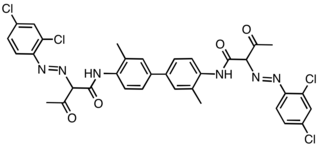Pigment Yellow 16
Appearance

| |
| Identifiers | |
|---|---|
3D model (JSmol)
|
|
| ChemSpider | |
| ECHA InfoCard | 100.025.258 |
| EC Number |
|
PubChem CID
|
|
| UNII | |
CompTox Dashboard (EPA)
|
|
| |
| |
| Properties | |
| C34H28Cl4N6O4 | |
| Molar mass | 726.44 g·mol−1 |
| Appearance | Yellow solid |
Except where otherwise noted, data are given for materials in their standard state (at 25 °C [77 °F], 100 kPa).
| |
Pigment Yellow 16 is an organic compound that is classified as a diarylide pigment.
Pigment Yellow 16 is used as a yellow colorant, and is classified as an arylide yellow. Also called permanent yellow, its color index number is 20040.[1] The compound is obtained via acetoacetylation of o-tolidine using diketene. The resulting bisacetoacetylated compound is coupled with two equiv of the diazonium salt obtained from 2,4-dichloroaniline.[2]
References
- ^ "The Color of Art Pigment Database: Pigment Yellow, PY". Art is Creation.
- ^ K. Hunger. W. Herbst "Pigments, Organic" in Ullmann's Encyclopedia of Industrial Chemistry, Wiley-VCH, Weinheim, 2012. doi:10.1002/14356007.a20_371
